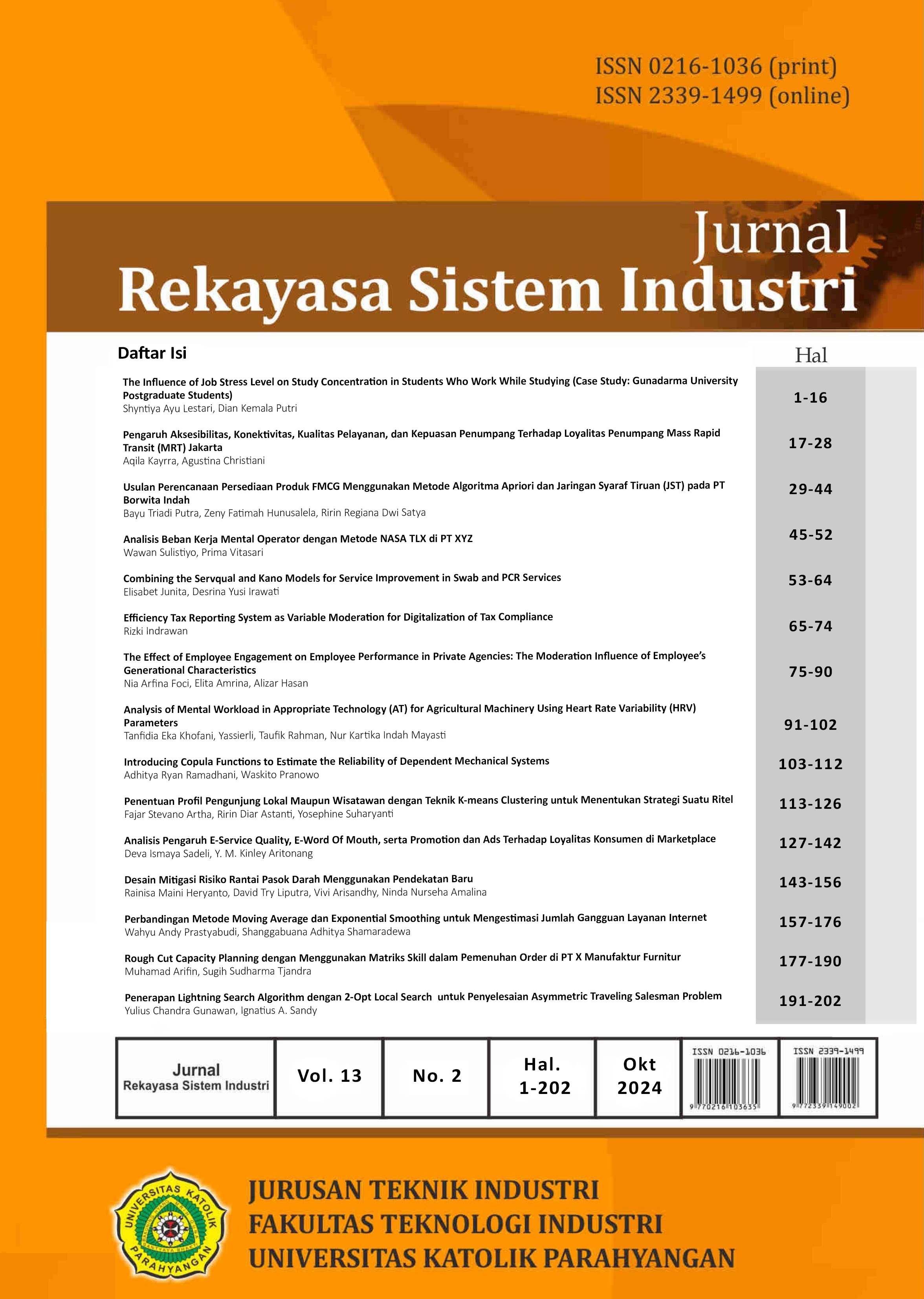Analysis of Operators' Mental Workload Using the NASA-TLX Method at PT XYZ
DOI:
https://doi.org/10.26593/jrsi.v13i2.7087.45-52Abstract
PT XYZ is a fermentation industry that uses Human Machine Interfaces (HMI) in the production process. With high mental workload of operators, it can disrupt company productivity. In 2021, the achievement of the percentage of production failure targets at PT XYZ has not reached the set target. The purpose of this study is to measure and make improvements to the mental workload at PT XYZ. The research method is to measure mental workload using the NASA TLX questionnaire, conduct data analysis using descriptive statistics, and conduct a paired t-test to compare the results of mental workload before and after improvement.. From the research results, the mental workload score was 72.64 in the high category. Of the six NASA TLX dimensions, operators experienced time demands of 24.1%, effort 23.1%, mental demands 22.3%, performance 20.2%, physical demands 9.3% and frustration 1.0%. The improvement results can reduce the high mental workload of operator from 82 to 74 with a significant level of 0.004, and increase the low mental workload of operators from 53 to 66 with a significant level of 0.129.
References
Braarud, P.Ø. (2021). Investigating the validity of subjective workload rating (NASA TLX) and subjective situation awareness rating (SART) for cognitively complex human–machine work. International Journal of Industrial Ergonomics, 89, 103233. https://doi.org/10.1016/j.ergon.2021.103233
Cain, B. (2007). A Review of the Mental Workload Literature. Defence Research and Development Toronto (Canada), 1998, 4-1-4–34. http://www.dtic.mil/cgi-bin/GetTRDoc?Location=U2&doc=GetTRDoc.pdf&AD=ADA474193
Ghalenoei, M., Mortazavi, S. B., Mazloumi, A., & Pakpour, A. H. (2021a). Impact of workload on cognitive performance of control room operators. Cognition, Technology and Work, 0123456789. https://doi.org/10.1007/s10111-021-00679-8
Ghalenoei, M., Mortazavi, S. B., Mazloumi, A., & Pakpour, A. H. (2021b). Impact of workload on cognitive performance of control room operators. Cognition, Technology and Work. https://doi.org/10.1007/s10111-021-00679-8
Ghanavati, F. K., Choobineh, A., & Keshavarzi, S. (2019). Assessment of mental workload and its association with work ability in control room operators. 389–397. https://doi.org/10.23749/mdl.v110i5.8115
Hancock, G. M., Beach, L., & Hancock, P. A. (2021). Chapter 7 Mental Workload What Is Mental and Cognitive
Hart, S. G., & Staveland, L. E. (1988). Development of NASA-TLX (Task Load Index): Results of Empirical and Theoretical Research. Advances in Psychology, 52(C), 139–183. https://doi.org/10.1016/S0166-4115(08)62386-9
Hutabarat, J. (2018). Kognitif Ergonomi. Journal of Physics A: Mathematical and Theoretical, 44(8), 1689–1699.
Made, N., & Wulanyani, S. (2015). Tantangan dalam Mengungkap Beban Kerja Mental. Buletin Psikologi, 21(2), 80. https://doi.org/10.22146/bpsi.7372
Morales, A. F. C., Hernandez Arellano, J. L., Muñoz, E. L. G., & Macías, A. A. M. (2020). Development of the NASA-TLX Multi Equation Tool to Assess Workload. International Journal of Combinatorial Optimization Problems and Informatics, 11(1), 50–58. https://search.proquest.com/docview/2314323230?accountid=31491
Rachmuddin, Y. (2020). MENGOPTIMALKAN JUMLAH ENGINEER DI BAGIAN ELECTRICAL / INSTRUMENT ENGINEERING ( Studi Kasus di PT Vale Indonesia Tbk ).
Rubio, S., Díaz, E., Martín, J., & Puente, J. M. (2004). Evaluation of Subjective Mental Workload: A Comparison of SWAT, NASA-TLX, and Workload Profile Methods. Applied Psychology, 53(1), 61–86. https://doi.org/10.1111/j.1464-0597.2004.00161.x
Sujarweni, V. W., (2015). SPSS Untuk Penelitian. Yogyakarta: Pustaka Baru Press.
Tarwaka, Bakri, S. H. A., & Sudiajeng, L. (2004). Ergonomi untuk Keselamatan, Kesehatan Kerja dan Produktivitas. Surakarta: Uniba Press
Warm, J. S., Parasuraman, R., & Matthews, G. (2008). Vigilance requires hard mental work and is stressful. Human Factors, 50(3), 433–441.https://doi.org/10.1518/001872008X312152
Young, M. S., Brookhuis, K. A., Wickens, C. D., & Hancock, P. A. (2015). State of science: mental workload in ergonomics. In Ergonomics (Vol. 58, Issue 1, pp. 1–17). Taylor & Francis. https://doi.org/10.1080/00140139.2014.956151

